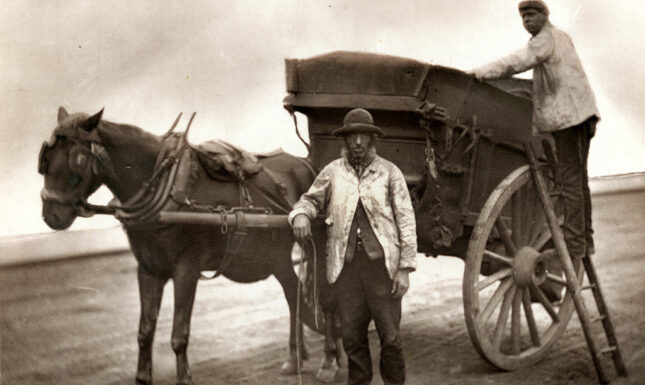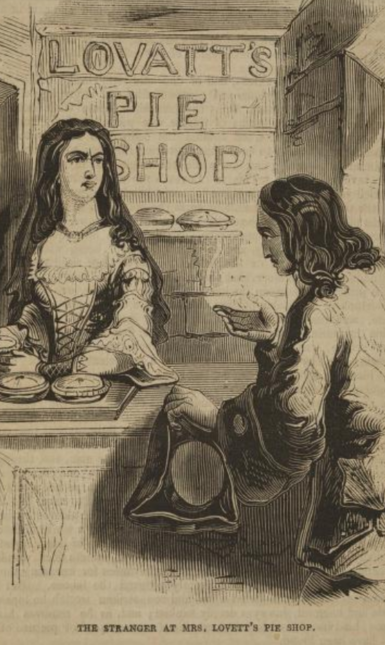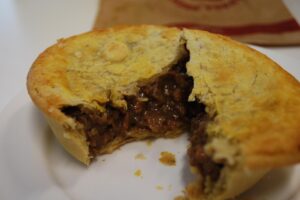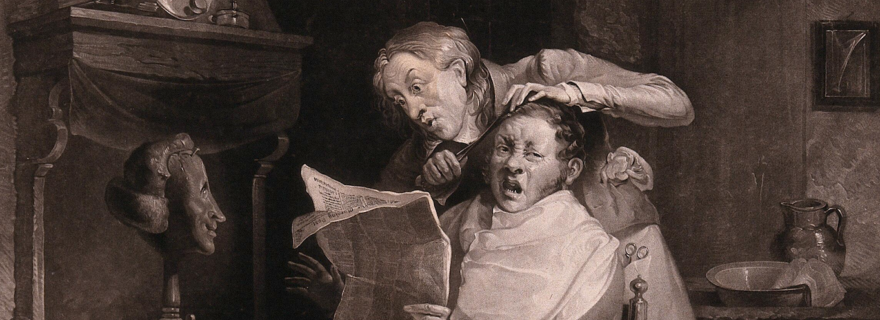Would Murder Be More Sustainable if All That Meat Didn’t Go to Waste? A Look at Garbage in Sweeney Todd’s Story
When we carefully separate paper from plastic, we hope that our waste will find a second life. But in which bin does crime evidence go? Angel Perazzetta discusses a Victorian tale of murder, greed and cannibalism, where an unscrupulous barber grapples with a trash-related dilemma.
Recycling isn’t a newfangled fad – that makes intuitive sense: there is no way that, given how much labour was involved in producing things in the pre-industrial era, it would have been possible to just toss aside and forget about broken, worn-out or generally unwanted objects. Indeed, there is plenty of historical evidence that Romans recycled glass, used parchment was often repurposed in the Middle Ages and that, already in the Bronze Age, metal was routinely melted down and put to new use.
Industrialization however didn’t put a stop to the necessity to give a new life to discarded objects – quite the opposite. In 19th-century London, for example, thousands of people made a living by sorting through the metropolis’ trash. Some engaged in the rag-and-bone trade, collecting scraps of linen and cotton (to sell to papermakers) and bones (used in the manufacture of various objects, such as knife handles and toothbrushes); others went door-to-door collecting ashes, useful to make mortar; yet others took advantage of the tidal nature of the river Thames, and scoured its banks for potentially valuable finds (respectively: Müller 2014, 166-68; Smith 1877, 93-94; Mayhew 1861, 155). The processing of garbage, in short, was an essential metabolism for 19th-century cities.
But how does the process of repurposing waste figure into literature? To explore this question, let’s look at a narrative depicting the circulation of a very unique type of trash – namely, human remains. The text discussed here, The String of Pearls, is a penny blood, an example of serial literature meant for working-class audiences; readers of penny bloods would follow a (typically gory and shocking) narrative through inexpensive weekly instalments. Contemporary opinion tended to regard penny literature in very negative terms, perhaps even as trash. That is in part because of its complete absence of artistic pretensions, in part because of the working-class audience it addressed, and in part, because of the violent subjects it depicted (as discussed in Morse 2004; Chesterton 1904, 9-10*). Penny bloods were entertainment for the masses, whose interest they held by artlessly stimulating strong emotional responses. Despite the dubious literary merit of penny fiction, it nonetheless reached a readership many times larger than the texts now regarded as canonical examples of Victorian literature. One could make the case that, to get a sense of 19th-century urban life, it makes more sense to turn to these ‘trashy’ popular texts than to the novels and poems intended for middle- and upper-class audiences.

Condensed to the extreme, the plot of The String of Pearls can be pitched as follows: a murderous barber and a woman selling meat pies are in cahoots – he provides excellent pie filling for free, while she helps him get rid of a large portion of the bodies that would otherwise cause inconvenience. As the barber’s customers keep vanishing into thin air, the police investigate the case.
The attractions of such a pulpy story are clear: there’s a serial murderer methodically slaughtering his victims at the heart of the city, there’s unwitting cannibalism (the customers of Mrs Lovett’s pie shop are under the impression that they are eating pork and veal), there’s the reassuring feeling that – no matter how ruthless metropolitan life gets – at least there are worthy policemen working to protect the population from such horrifying threats. There is also a love story, which is what prompts the investigation, but it is (in this writer’s estimation) much less interesting than the sticking-people-into-pies plot.
What does this have to do with trash? I would argue that the dead bodies involved in Mrs Lovett and Sweeney Todd’s schemes could be understood as rubbish, as waste products that need to be harmlessly disposed of. At its core, then, The String of Pearls is a story about waste management.
Granted, human remains are not usually perceived in terms of waste; instead, they are seen as departed loved ones, or at least respected as fellow human beings. Someone deciding to start a career as a serial killer, however, cannot afford to be so sentimental. Finding a reliable way to get rid of their victims’ mortal remains becomes a pressing practical challenge. It is not an easy problem to solve: human beings are large, they quickly start emitting foul smells, and they are likely to raise unwanted questions if anyone spots them outside of a morgue or other similarly culturally-approved places. So, jarring as it is, Todd’s murdering scheme largely depends on logistics – on his ability to quietly secrete human bodies out of sight and out of neighbours’ olfactory range.
You might notice that Todd’s dilemma resembles the challenges faced by those managing ordinary waste, even today. Adopting a solution that we are all familiar with, Todd’s corpse disposal system depends on the separation of useful, recyclable material – in this case, the meat – from the truly worthless portion, which can only be stuck somewhere in the hope that it will not cause any further problems (such as polluting groundwaters or, in Todd’s case, arousing fellow Londoners’ suspicions).

The reuse scheme turns out to be a success: thanks to their juicy morsels of meat, Mrs Lovett’s pie shop becomes a beloved institution within the neighbourhood. Whenever a new batch of pies comes out of the oven, the shop is besieged with hungry customers happy to unknowingly conceal crime evidence in their stomachs (an attractive way to destroy murder evidence, as Roald Dahl’s short story “Lamb to the Slaughter” shows). Significantly, however, these enthusiastic gourmands don’t just consume human bodies – they pay for them, turning Mrs Lovett’s business into a very profitable venture. This recycling process, then, turns something ordinarily invaluable (a human body, something placed outside of the workings of the market) into something with a monetary price, something through which profit can be made.

Those parts of human bodies that cannot be turned into meat pie filling – the bones, the internal organs, the hair – are involved in the opposite form of circulation. These materials are stashed by Todd in the long-unused crypts of the nearby church of St. Dunstan’s. Eventually, these piles of rotting material begin emitting such a stench that it becomes a problem for the church-going community: as sitting through a service becomes a deeply unpleasant experience, church attendance begins to drop, and visiting clergymen refuse to give mass. (Eventually, the mysterious smell attracts the attention of Sir Blunt, the lead investigator on Todd’s case, leading him to conclusively prove that Todd’s disappearing customers were indeed murdered). While Mrs Lovett’s pie shop represents a profitable (if morally dubious) mode of processing trash, St. Dunstan’s represents the flip side of the coin. The human remains in its crypts, too, start out as part of an ordinarily invaluable whole, but they instead turn into completely worthless and repulsive matter, something one would much rather pay to get rid of than to acquire.
In The String of Pearls, then, we can see the two sides of trash: on the one hand, its generative potential, its ability to retain value and be turned into something useful again; on the other, its abject nature, its abhorrent threat to spill over into the world and taint it. This duality might be at the very core of what trash is – not matter out of place, as Douglas famously described dirt, but matter perched on the edge between value and abjection (Douglas 1992, 36). The String of Pearl’s concern with the valuation of trash reflects, perhaps, its position as a literary text: a profitable venture much cherished by its captivated readership, and at the same time – according to certain critics, at least – an alarming perversion of the noble art of literature.
Note
* Home of the admirable (and very true) sentence: “A man does not walk down the street giving a haughty twirl to his moustaches at the thought of his superiority to some variety of deep-sea fishes” (Chesterton 1904, 9).
Works Cited
Chesterton, G. K. 1904. The Defendant. New York: Dodd, Mead & Company; London: R. Brimley Johnson.
Douglas, Mary. 1992. Purity and Danger: An Analysis of the Concepts of Pollution and Taboo. London; New York: Routledge.
Morse, Samantha. 2019. ‘Affective Ethics and Democratic Politics in Sweeney Todd and the Victorian Penny Press’. Journal of Victorian Culture 24 (1): 1–17. https://doi.org/10.1093/jvcult/vcy054.
Mayhew, Henry. 1861. London Labour and the London Poor (vol. II). London: Griffin, Bohn, and Company.
Müller, Lothar. 2014. White Magic: The Age of Paper. Cambridge, UK; Malden, MA: Polity.
Smith, Adolphe. 1877. Street Life in London. London: Sampson Low, Marston, Searle & Rivington.
See also
Flanders, Judith. The Victorian House: Domestic Life from Childbirth to Deathbed. London, Harper Perennial, 2004.
Mack, Robert L. The Wonderful and Surprising History of Sweeney Todd: The Life and Times of an Urban Legend. London, Continuum, 2007.
Powell, Sally. 2004. “Black Markets and Cadaverous Pies: The Corpse, Urban Trade and Industrial Consumption in the Penny Blood.” Victorian Crime, Madness and Sensation, edited by Grace Moore and Andrew Maunder, Routledge, Taylor & Francis Group, 2004, p. 45-58.
Strasser, Susan. 1999.Waste and Want: A Social History of Trash. New York: Metropolitan Books.
Unknown (probably James Malcolm Rymer or Thomas Peckett Prest). 1850. The String of Pearls. London, E. Lloyd, 1850. Available on the Internet Archive: https://archive.org/details/stringofpearlsor00ryme/mode/2up.
© Angel Perazzetta and Leiden Arts in Society Blog, 2023. Unauthorised use and/or duplication of this material without express and written permission from this site’s author and/or owner is strictly prohibited. Excerpts and links may be used, provided that full and clear credit is given to Angel Perazzetta and Leiden Arts in Society Blog with appropriate and specific direction to the original content.



0 Comments